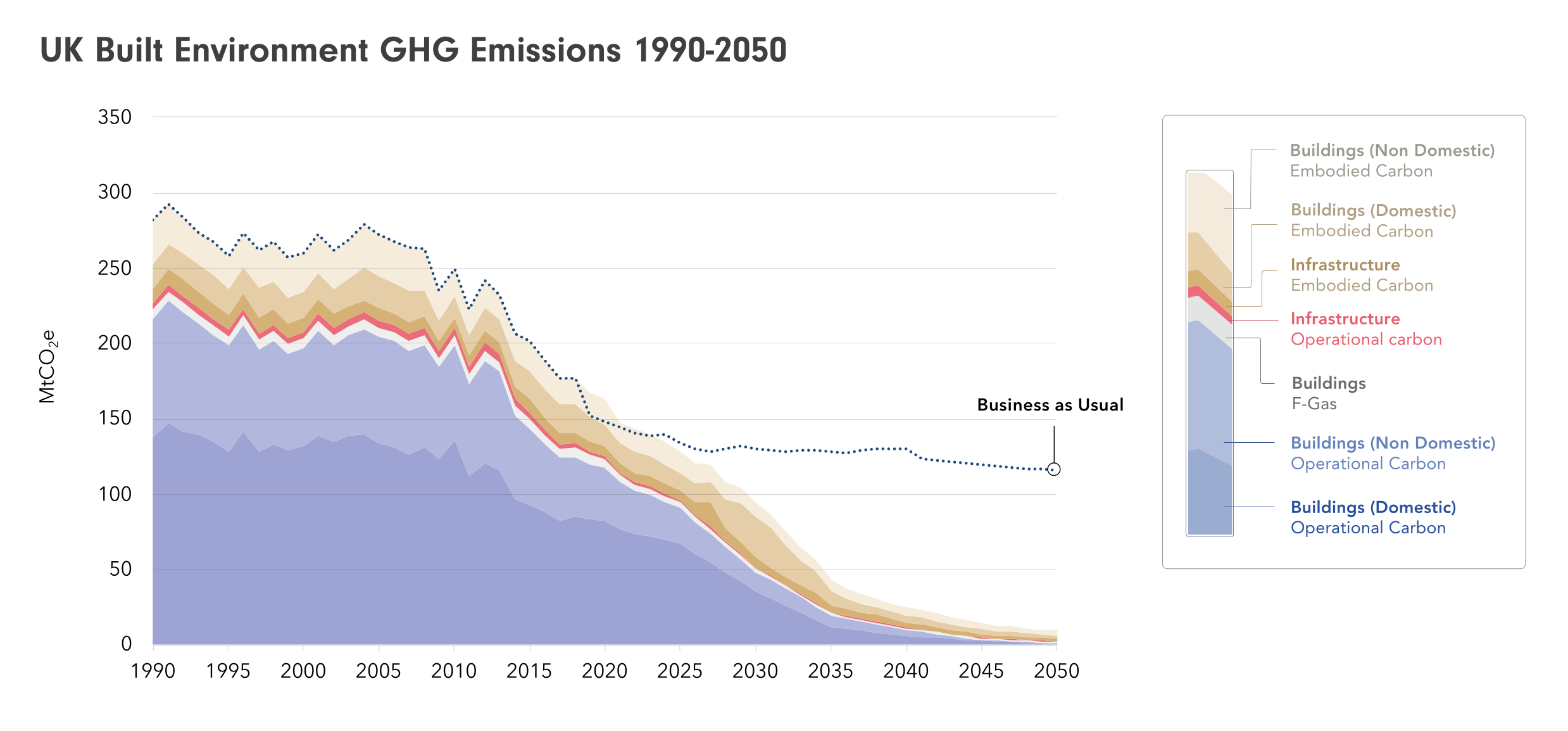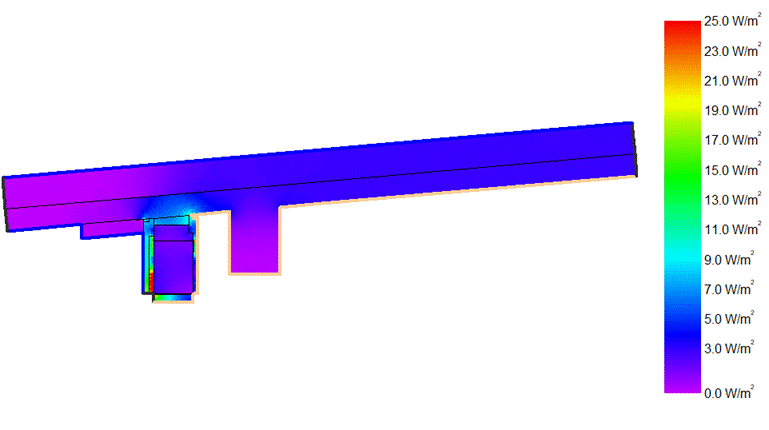Assessing Thermal Performance
Toby Cambray

The UK’s commitment to attaining net zero carbon emissions by 2050 under The Climate Change Act 2008 poses substantial challenges for the built environment
(Graph: UK Green Building Council 2021)
Climate change remains the defining issue of our time, but most of the buildings considered to be heritage assets were constructed before carbon emissions had reached the scale we now know to be problematic.
Estimates vary but the operation of UK buildings contributes to around 40 per cent of the UK’s domestic carbon emissions, and much of this is due to heating.
Older buildings are sometimes branded wholesale as draughty and inefficient, perhaps unfairly. Nonetheless, the operation of these buildings does contribute a significant amount to carbon emissions, and if we are to meet the targets set out in the Climate Change Act 2008, we must consider what might be done to reduce these emissions.
There is enormous variety in what might be considered a historic building: in scale, construction, usage and, of course, age. All of these factors, and many more besides, must be taken into consideration when deciding what interventions, if any, are appropriate to reduce the carbon emissions associated with each building.
On the other hand, older buildings have a super-power which has only been brought to mainstream attention in recent years – simply, that they already exist.
For many years the issue of up-front emissions (including those caused during the construction of the building and by the manufacture of its components) has been a fringe interest, but the embodied carbon (or energy) of existing buildings is now coming to prominence as an essential issue to consider in construction.
This means every existing building has an essential role to play in minimising the effects of climate change. The crisis is upon us, and while the operational energy use over the coming decades is important, the up-front carbon implications are arguably at least as important.
In this context it makes no sense to knock down and rebuild, no matter how efficient the replacement. Retaining older buildings is therefore an essential part of our response.
If it is possible to improve the operational efficiency without compromising the structure and character of a building, so much the better.
The cost of energy is rarely out of the news for long; for as many years as I have been working in the industry it seems that autumn brings headlines about price increases as surely as the leaves fall from the trees.
2021 will also be remembered as the year of the supplier bankruptcies, which some argue is down to a combination of wholesale price hikes and clumsy legislation, in particular retail price caps.
The cost of energy puts pressure on heritage buildings in a world where assets are expected to pay their way, so improving their efficiency often has a role in ensuring a building’s ongoing use.
For all these reasons and others, carefully considered retrofit to reduce each building’s contribution to climate change should be a priority. The first step in this process is understanding a building’s current performance, which is the subject of this article.
Motivation
One of the success stories of recent years is the dramatic reduction in the carbon intensity of generating the UK’s electricity, which is now, unit for unit, less carbon intensive than gas, on average.
Furthermore, as a heat pump can generate around three units of heat for each unit of electricity, a direct electric heater would result in less carbon emissions than a gas boiler.
Does this mean we should swap our heater from gas to electric? While this seems simple from the perspective of each building, unfortunately at a national scale this is problematic: the electricity infrastructure has nowhere near enough capacity and a significant low carbon expansion would be expensive.
There is therefore a balance to strike between reducing demand (by improving the thermal performance of our buildings) and transitioning our infrastructure.
Within this balance there is arguably room to leave some of our most sensitive assets largely untouched and accept the energy related costs of our national enjoyment of unique buildings. The rest, however, must be upgraded as part of our response to the climate crisis.
Methods of Assessment

Dynamic modelling of the heat flow through the external envelope of a building helps us to understand its thermal performance, but it cannot take into account irregularities in historic structures.
Careful assessment of a building’s thermal performance is necessary to identify both the most effective retrofit approach and the safest, as energy retrofitting exposes all buildings to some risks.
Many of these are associated with moisture because the movement of heat is closely linked with that of water.
Historic buildings generally manage moisture in very different ways to modern buildings, so materials, detailing and techniques must be carefully selected and designed to minimise these risks.
Observations
Most assessments, of whatever sort, begin with simply looking at the building and maybe at drawings if they are available. A skilled surveyor, from any discipline, can discern a great deal from careful observation.
When we look carefully, buildings tell us their stories, which can be as useful as they are fascinating. A simple but very accurate approach to assessing any building’s thermal performance is to inspect energy bills, and sometimes other data, for example submetering information that is sometimes available in larger commercial buildings with more complex systems.
The meter never lies, and a simple table or bar graph of monthly figures can be revealing. We can get very rough estimates of, for example, the energy used for hot water as opposed to space heating.
This is a simple form of ‘disaggregation’ – estimating what proportion of energy goes to different enduses – which is extremely useful because it helps us understand how to allocate resources for the best result.
It is also typical to ‘normalise’ the data by dividing it by the floor area so the information can be compared with buildings of a different size.
Modelling and simulation
Calculations, modelling and simulation can play an important role in the assessment of thermal performance. These can range from simple u-value calculations on individual elements, to energy models of entire buildings or even stocks of buildings, perhaps on the books of a housing authority.
It is, however, essential to bear in mind that, in the words of the statistician George Box, ‘all models are wrong but some models are useful’.
A pertinent example of how wrong models can be in this context is the persistent over-estimation risk, at least in comparison to doing the physical work to the building.
This means that scenarios can be explored, informing design decisions. It is crucial, however, that decisions are not driven by a crude target set against an over-simplistic model.
Unfortunately, the use of Energy Performance Certificate (EPC) scores as targets falls squarely into this trap. The correlation between EPC scores and measured energy use is weak, casting doubt on the efficacy of this approach.
Furthermore, a simple energy model cannot take into account the moisture risks associated with altering the thermal performance of a building any more than it can assess its heritage value.
Other targets for the energy or carbon performance of retrofit projects have been proposed, for example the recent LETI retrofit guide, the AECB CarbonLite retrofit standard and EnerPHit (the Passivhaus retrofit standard).
The recently launched revisions to Part L do not specify an overall energy or carbon target, keeping instead the simplified approach of elemental U-value requirements. PAS 2030, the technical standard underpinning the ill-fated Green Deal, does.
Technical monitoring
As the old saying goes, you can’t manage what you can’t measure. Happily, the technical and economic barriers to the monitoring of simple parameters such as temperature and humidity have fallen significantly over the decades.
A temperature logger capable of running autonomously for six months or more can be had for mere tens of pounds. Much more comprehensive and sophisticated systems are also available, and as with simulation, the most appropriate tool must be chosen for each situation.
An excellent approach to designing a monitoring campaign is to carefully frame a question or set of questions that need to be answered, such as ‘what temperature does the heating system deliver in the bedroom’, or ‘what is the space heating energy demand?’
With some clear questions in hand, the appropriate parameters can be selected, the accuracy and precision of sensors confirmed, and the duration of the monitoring chosen.
The last factor can range from a single ‘spot’ measurement with a hand-held moisture meter for example, to a few hours during a single visit, up to days, months or years.
A problem with these approaches is that they can be relatively expensive, at least in the context of single dwellings, and each building must be analysed individually; the varying patterns of occupancy, thermostat settings and so on make comparisons between buildings difficult.
Recently, a number of companies have launched proprietary systems that integrate hardware and software to deliver what might be considered a ‘true’ asbuilt score for the building fabric alone.
A range of sensors measures the energy consumption as well as temperatures, occupancy patterns and so on.
Machine learning techniques are used to factor-out confounding variables to provide a result that describes the thermal quality of the fabric, irrespective of the factors that in the past made comparison difficult.
Conclusions
Heritage buildings have a crucial role to play in our response to the climate crisis. The carbon footprint of all buildings must be reduced, whether that be by switching to low carbon forms of energy for heating, reducing the energy demand by improving the thermal performance of the building fabric, or both.
The most appropriate balance of measures will vary from building to building, and to make good decisions about this we must have a proper understanding of the thermal behaviour of each building.
There are various tools available to do this, from simple observations, a multitude of measurements that can be taken and a range of calculations, models and simulations that can help us make decisions.
However, these methods and tools are just part of a process which must encompass many more factors if we are to safeguard our built heritage while responding to the climate emergency.



